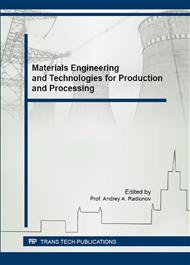p.236
p.242
p.248
p.253
p.259
p.263
p.269
p.274
p.278
Pilot Testing of the Waste Metalworking Fluids Biosorption Treatment
Abstract:
Metalworking fluids are liquid wastes of the machines cutting, cooling, and lubrication operations coming in the form of emulsified oil. Waste metalworking fluids in the emulsified form are liberated into the environment through machining wastewater which becomes contaminated with microorganisms and results in a drastic problem of water pollution. To reduce its polluting biosorption the method of treating waste metalworking fluids was employed. An investigation into the anaerobic biological wastewater treatment was conducted for 50 days with the initial sludge dose 2.8 g/l in a horizontal tank with a drum-type mixing device. The results of this study indicate that the existing industrial-activated sludge plant could be used to treat waste MWFs under anaerobic conditions after the additional treatment by fermentation at a temperature of 32-37 оС with nutritional elements input at certain days. The efficiency of biosorption treatment using the granular diatomite as an adsorbent is insignificantly inferior to the system with granular activated carbon SKT-3. So it would be more reasonable to use the diatomite in industrial plants because it is significantly cheaper than the granular activated carbon and there are large quantities available. The COD reduction was significant but to achieve optimum performance further investigation is needed.
Info:
Periodical:
Pages:
259-262
Citation:
Online since:
February 2016
Authors:
Keywords:
Price:
Сopyright:
© 2016 Trans Tech Publications Ltd. All Rights Reserved
Share:
Citation:


